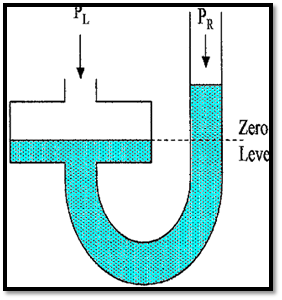2.Pressure Measurement-Manometers
Pressure Measurement-Manometers
There
are three types of Manometer which are explained below.
1) Open U-type Manometer: Manometers are
working on the principle of hydrostatic balancing.
Manometer
consists of a tube made of glass or other transparent material bent into the
shape of a U and with both ends left open.
The
force acting due to one liquid column on the same level or reference balances
the force acting due to another liquid column.
Highly
refined mineral seal oils of various densities are used in manometry for small
pressure differences.
For
higher pressure ranges mercury is used.
Water
is not generally used because it evaporates, leaves a lime deposit on the tube
wall
Since
the pressure acting on the liquid column it will form a meniscus, When the
meniscus is concave, the liquid column should be measured to the bottom of the
meniscus.
When
the meniscus is convex, the column should be measured to the top of the
meniscus.
Accuracy of Manometer:
Accuracy
is not affected by the shape or size of the tube.
Manometer
liquid used could affect the accuracy of the Measurement.
When
high specific- gravity liquids are used to measure extremely small pressures,
the following are important variables affect the accuracy:
Density.
Vapor
pressure.
Temperature.
2) Well type of Manometer: The left-hand limb
is replaced by a reservoir or well which has an area much larger than the area.
This operates on the principle of Pascal law.
Pressure to be measured is applied on the well side
and the reference pressure is applied on other side.
It is mainly used in laboratory and industrial
purposes.
3) Inclined Manometer: It has one limb that is inclined at an angle to the horizontal plane and a vertical limb that consists of a relatively large well. The sloping tube carries a scale adjacent to it. Inclined tube is used to achieve a longer scale than the ordinary U-tube manometer for the same pressure differentials.
Advantages of manometers with respect
to other inst.
1. Range is ± 30 inch of Hg.
2. Suitable for very low pressure Measurement.
3. The liquid is physically visual.
Disadvantages:
1. Bulky, size is big.
2. Glass tube is fragile so it is not
recommended for field use.
3. Accuracy of the instrument is depending up
to the temperature and other factors, which cannot maintain in field.
4. Mercury used in manometer make mercury
oxide, which is poisonous.
5. Manometers are not suitable for high
pressure Measurement and high temperature pressure Measurement.
6. Manometer’s liquid may react with the
process liquid.




Comments
Post a Comment